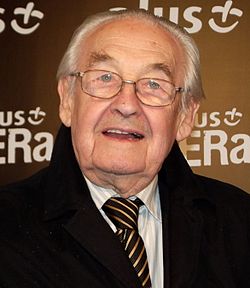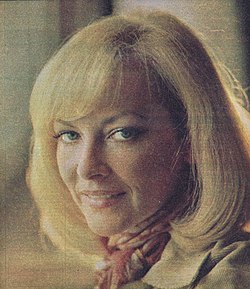Early history
Preserved frame from Przygoda dorożkarza - cabman notices that someone replaced his horse with a donkey
Museum of cinematography in
Łódź The first cinema was founded in Łódź in 1899, several years after the invention of the Cinematograph. Initially dubbed Living Pictures Theatre, it gained much popularity and by the end of the next decade there were cinemas in almost every major town in Poland. Arguably the first Polish filmmaker was Kazimierz Prószyński, who filmed various short documentaries in Warsaw. His pleograph film camera had been patented before the Lumière brothers' invention and he is credited as the author of the earliest surviving Polish documentary titled Ślizgawka w Łazienkach (Skating-rink in the Royal Baths , also known as On skating-rink [6] ), made between 1894 and 1896, as well as the first short narrative films Powrót birbanta (Rake's return home) and Przygoda dorożkarza (Cabman's Adventure), both created in 1902. Another pioneer of cinema was Bolesław Matuszewski, who became one of the first filmmakers working for the Lumière company - and the official "cinematographer" of the Russian tsars in 1897.
The earliest surviving short film is Pruska kultura (Prussian Culture) and the earliest surviving feature film is Antoś pierwszy raz w Warszawie (Antoś for the First Time in Warsaw). Both of them were made in 1908, the first one by an unknown director and the second one by Antoni Fertner. The date of Antoś' première, October 22, 1908, is considered the founding date of the Polish film industry. Soon Polish artists started experimenting with other genres of cinema: in 1910 Władysław Starewicz made one of the first animated cartoons in the world - and the first to use the stop motion technique, the Piękna Lukanida (Beautiful Lukanida). By the start of World War I the cinema in Poland was already in full swing, with numerous adaptations of major works of Polish literature screened (notably the Dzieje grzechu , Meir Ezofowicz and Nad Niemnem ).
During World War I the Polish cinema crossed borders. Films made in Warsaw or Vilnius were often rebranded with German-language intertitles and shown in Berlin. That was how a young actress Pola Negri (born Barbara Apolonia Chałupiec) gained fame in Germany and eventually became one of the European super-stars of silent film.
The first woman to direct a film in Poland and the only female film director of the Polish silent film era was Nina Niovilla. [7] [8] She debuted in 1918 in Berlin, [7] and then directed her first Polish film [7] titled Tamara (also known under the title Obrońcy Lwowa) in 1919. [7] [8]
During World War II, Polish filmmakers in Great Britain created the anti-Nazi color film Calling Mr. Smith [9] [10] [11] (1943) about Nazi crimes in occupied Europe and about Nazi propaganda. It was one of the first anti-Nazi films in history being both an avant-garde and a documentary film. [12]
After WWII
In November 1945, the communist government founded the film production and distribution organization Film Polski, and put the well-known Polish People's Army filmmaker Aleksander Ford in charge. Starting with a few railway carriages full of film equipment taken from the Germans they proceed to train and build a Polish film industry. The FP output was limited; only thirteen features were released between 1947 and its dissolution in 1952, concentrating on Polish suffering at the hands of the Nazis. [13] In 1947, Ford moved to help establish the new National Film School in Łódź, where he taught for 20 years.
The industry used imported cameras and film stocks. At first ORWO black and white film stock from East Germany and then Eastman colour negative stock and ORWO print stocks for rushes and release prints. Poland made its own lighting equipment. Because of the high costs of film stock Polish films were shot with very low shooting ratios, the amount of film stock used in shooting the film to length of the finished film. The equipment and film stock were not the best and budgets were modest but the film makers received probably the best training in the world from the Polish Film School. Another advantage was Film Polski's status as a state organisation, so its film-makers had access to all Polish institutions and their cooperation in making their films. Film cameras were able to enter almost every aspect of Polish life.
The first film produced in Poland following the World War II was Zakazane piosenki (1946), directed by Leonard Buczkowski, which was seen by 10.8 million people (out of 23,8 total population) in its initial theatrical run. [14] Buczkowski continued to make films regularly until his death in 1967. Other important films of the early post-World War II period were The Last Stage (1948), directed by Wanda Jakubowska, who continued to make films until the transition from communism to capitalism in 1989, and Border Street (1949), directed by Aleksander Ford.
By the mid-1950s, following the end of Stalinism in Poland, Film production was organised into film groups. A film group was a collection of film makers, led by an experienced film director and consisting of writers, film directors and production managers. They would write scripts, create budgets, apply for funding off the Ministry of Culture and produce the picture. They would hire actors and crew, and use studios and laboratories controlled by Film Polski.
The change in political climate gave rise to the Polish Film School movement, a training ground for some of the icons of the world cinematography, e.g., Roman Polański ( Knife in the Water , Rosemary's Baby , Frantic , The Pianist ) and Krzysztof Zanussi (a leading director of the so-called cinema of moral anxiety of the 1970s). Andrzej Wajda's films offer insightful analyses of the universal element of the Polish experience - the struggle to maintain dignity under the most trying circumstances. His films defined several Polish generations. In 2000, Wajda was awarded an honorary Oscar for his overall contribution to cinema. Four of his films were nominated for Best Foreign Language Film award at Academy Awards with seven other Polish directors receiving one nomination each: Roman Polański, Jerzy Kawalerowicz, Jerzy Hoffman, Jerzy Antczak, Agnieszka Holland, Jan Komasa and Jerzy Skolimowski. [15] In 2015, Polish filmmaker Paweł Pawlikowski received this award for his film Ida . In 2019, he was also nominated to the award for his next film Cold War in two categories - Best Foreign Language Film and Best Director. [16]
It is also important to note that during the 1980s, the People's Republic of Poland instituted the martial law to vanquish and censor all forms of opposition against the communist rule of the nation, including outlets such as cinema and radio. A notable film to have emerged during this period was Ryszard Bugajski's 1982 film Interrogation (Przesluchanie), which depicts the story of an unfortunate woman (played by Krystyna Janda) who is arrested and tortured by the secret police into confessing a crime she knows nothing about. The anti-communist nature of the film brought about the film's over seven-year ban. In 1989, the ban was repealed after the overthrow of the Communist government in Poland, and the film was shown in theaters for the first time later that year. The film is still lauded today for its audacity in depicting the cruelty of the Stalinist regime, as many artists feared persecution during that time. [17] [18]
In the 1990s, Krzysztof Kieślowski won a universal acclaim with productions such as Dekalog (made for television), The Double Life of Véronique and the Three Colors trilogy. Another of the most famous movies in Poland is Krzysztof Krauze’s The Debt , which became a blockbuster. [19] It showed the brutal reality of Polish capitalism and the growth of poverty. A considerable number of Polish film directors (e.g., Agnieszka Holland and Janusz Kamiński) have worked in American studios. Polish animated films - like those by Jan Lenica and Zbigniew Rybczyński (Oscar, 1983) - drew on a long tradition and continued to derive their inspiration from Poland's graphic arts. Other notable Polish film directors include: Tomasz Bagiński, Małgorzata Szumowska, Jan Jakub Kolski, Jerzy Kawalerowicz, Stanisław Bareja and Janusz Zaorski.
Among prominent annual film festivals taking place in Poland are: Warsaw International Film Festival, Camerimage, International Festival of Independent Cinema Off Camera, New Horizons Film Festival as well as Gdynia Film Festival and Polish Film Awards.
Cinema audience
The Communist government invested resources into building a sophisticated cinema audience. All the cinema were state owned and consisted of first run premiere cinema, local cinema and art house cinemas. Tickets were cheap and students and old people received discounts. In the city of Lodz there were 36 cinemas in the 1970s showing films from all over the world. There were the Italian films of Fellini, French comedies, American crime movies such as Don Siegel's "Charley Varrick" . Films were shown in their original versions with Polish subtitles. Anti-Communist and Cold War films were not shown, but a bigger restriction was the cost of some films. There were popular film magazines like "Film" and "Screen", critical magazines such as "Kino". This all helped to build a well informed film audience.



















